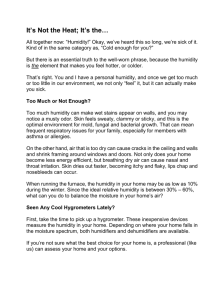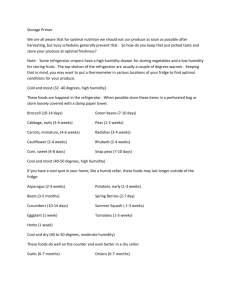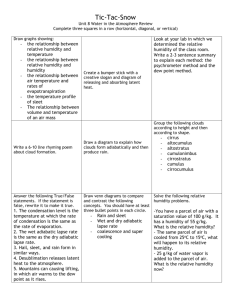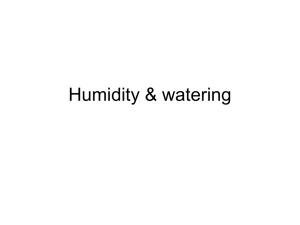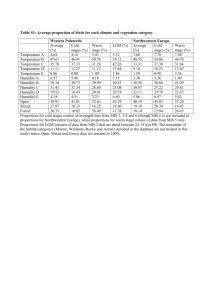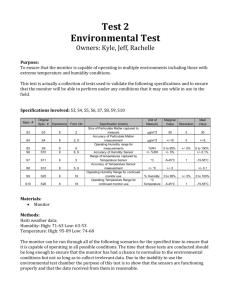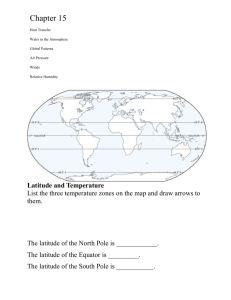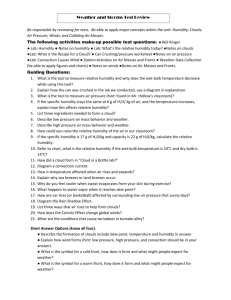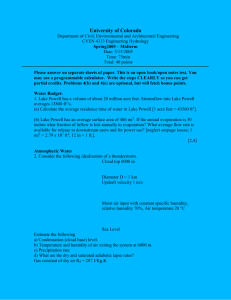Homework_3_Final
advertisement
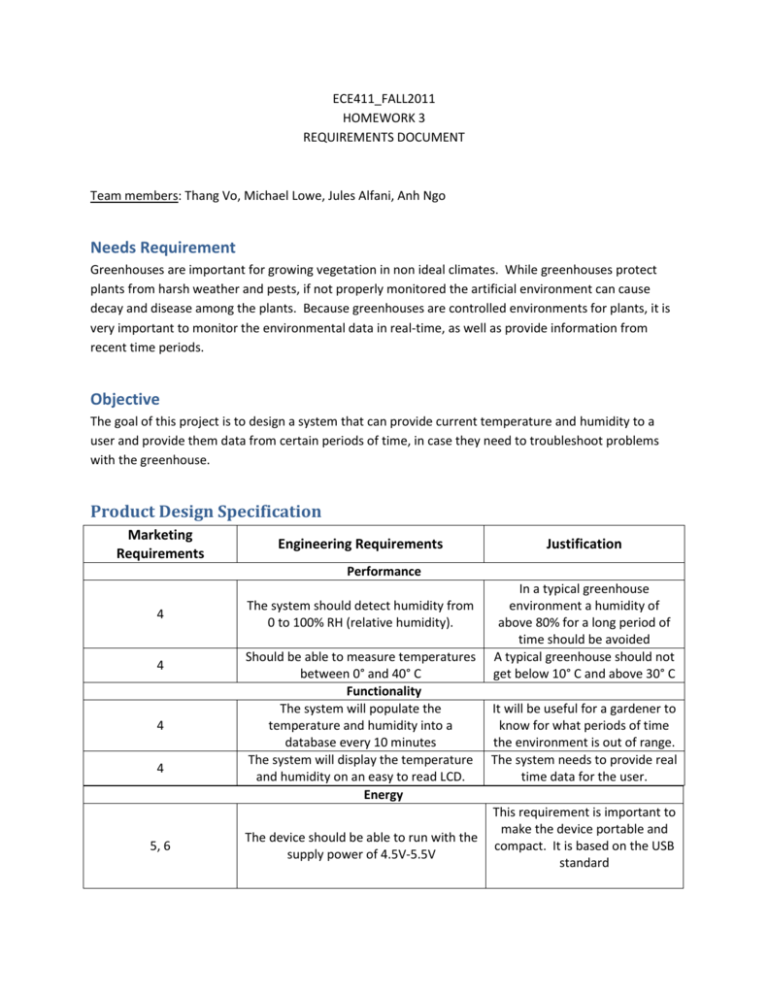
ECE411_FALL2011 HOMEWORK 3 REQUIREMENTS DOCUMENT Team members: Thang Vo, Michael Lowe, Jules Alfani, Anh Ngo Needs Requirement Greenhouses are important for growing vegetation in non ideal climates. While greenhouses protect plants from harsh weather and pests, if not properly monitored the artificial environment can cause decay and disease among the plants. Because greenhouses are controlled environments for plants, it is very important to monitor the environmental data in real-time, as well as provide information from recent time periods. Objective The goal of this project is to design a system that can provide current temperature and humidity to a user and provide them data from certain periods of time, in case they need to troubleshoot problems with the greenhouse. Product Design Specification Marketing Requirements Engineering Requirements Justification Performance 4 4 4 4 5, 6 The system should detect humidity from 0 to 100% RH (relative humidity). Should be able to measure temperatures between 0° and 40° C Functionality The system will populate the temperature and humidity into a database every 10 minutes The system will display the temperature and humidity on an easy to read LCD. Energy The device should be able to run with the supply power of 4.5V-5.5V In a typical greenhouse environment a humidity of above 80% for a long period of time should be avoided A typical greenhouse should not get below 10° C and above 30° C It will be useful for a gardener to know for what periods of time the environment is out of range. The system needs to provide real time data for the user. This requirement is important to make the device portable and compact. It is based on the USB standard 5, 6 The average power consumption of the microcontroller should be about 3.3mW (at 1MHz, 3V and 25oC) 4, 5, 6 The peak current going through the microcontroller must be less than 100mA 1, 2, 5 Maintainability Every electronic component assembled in the device must be easy-to-find 4, 5 Maintenance-period requirement should be less than two months 2 The mean time for fixing common errors should be less than half a day 1, 2 1, 7 1, 2 4, 5 1, 3 5 7 Manufacturability All of the elements should be chosen from one company without any change of product line The device must interact well with Window or Unix systems Design tools, assembly tools and testing tools have to be common Operational 3.3mW at such conditions is an intermediate value that would reflect normal operation. To guarantee that the device as well as the USB port are not overwhelmed This is critical to assure a quick fix when malfunctions occur To make the device long-lasting and competitive to other similar devices To ensure the sustainable operation when the device is set in place This help us to take advantage of large-quantity orders and makes the device sustainable The requirement guarantees that users can easily work with the device and the device itself can be widely distributed To optimize the process flow and reduce the cost of products The device is sustainable in temperature varying from -10 to 50 degrees C temperature range and humidity ranges from 0-100% RH The condition for greenhouse using the device is Temperature: 10-30 degrees Celsius RH: < 80 % Area of PCB should be no more than 16in2 PCB fab house only provides student the maximum PCB area of 16in2 Reliability The lifetime of the device should be at least 1 year Usability Interface is a user friendly window application. Based up on similar devices outside market Does not require any training or tutorial on using the application. Economic 1 The costs for developing or producing the system (parts) should not exceed $100. This is based upon, each student member in the team, financial budget. Health and Safety 8 The system will not expose humans to unhealthy levels of electromagnetic radiation. 9 The system will use only UL (Underwriter Laboratory) approved components. The IEEE C95.1-1991 Standard for Safety levels with Respect to Human Exposure to Radio Frequency Electromagnetic Fields is 3 kHz to 300 GHz. UL (Underwriter Laboratory) is a North American component certification program that requires component parts are suitable for installation and meet the Conditions of Acceptability. Environmental 9, 10 1. 2. 3. 4. 5. 6. 7. 8. 9. 10. 50% of the component parts should be recyclable, able to be repaired and reused in similar product. Oregon is an environmental friendly state with clear regulation on recycling and waste management. Marketing Requirements Should be low cost Easy to assemble and maintain Should be compact Can measure and display accurately Durable and a long life span Low power consumption Handy interface Safety Legal Contribute to environment protection http://njveg.rutgers.edu/assets/pdfs/ajb/Temperature%20Management.pdf http://www.howitworks.net/how-a-greenhouse-works.html


